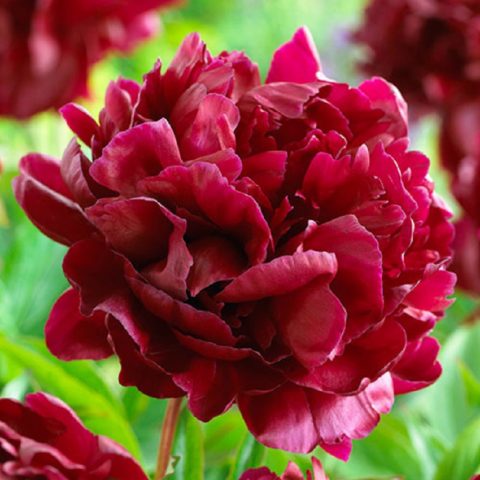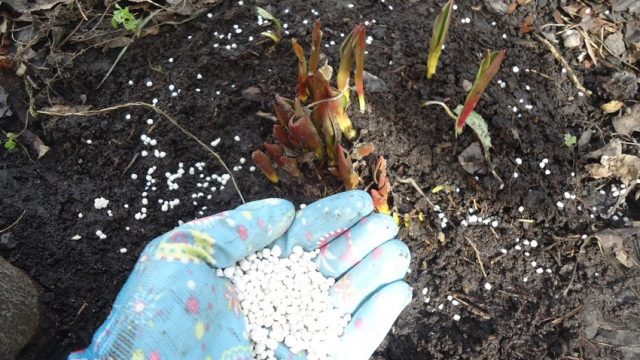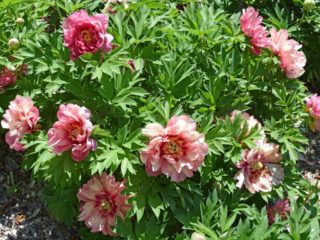Content
The Armani peony belongs to a variety of amazing flowers that have received recognition for their decorativeness and unpretentiousness. In different cultures, the plant is considered a symbol of prosperity. The huge number of varieties makes it difficult for gardeners to choose for their site. If you give preference to Armani, then among the garden crops there will be a luxurious peony bush with amazing flowers.

Luxurious Armani cannot be confused with another variety
Description of the Armani peony
Peony lovers pay first of all attention to the external characteristics of the bush. The purchase of a variety is always associated with the desire to decorate a composition or a specific place.
The Armani peony is considered a unique herbaceous species due to its extraordinary external parameters and beauty:
- The Armani variety bush reaches 90-100 cm in height, which gives the right to call it tall.
Even one bush can decorate a site, but it needs enough space
- The stems are strong and elastic. They can be weakly branched or erect. In any configuration, they hold their shape tightly. They do not need supports, but during the flowering period, supports will help to support lush inflorescences.
- The rhizome of the Armani variety is powerful and strong with thickened roots.
- The leaves are dark green, glossy, fluffy, openwork. Arranged alternately. They look very decorative, especially in autumn. During this period, the color of the foliage becomes burgundy-red.
In addition to external decorativeness, the Armani variety has other significant advantages. The frost resistance of the variety is much higher than other types of peonies. The flower also resists winds well. Shoots do not freeze when the temperature drops to -40 °C. Therefore, the perennial is cultivated in Russia, even in areas with a harsh climate. Armani also feels great in hot climates. Leaves and flowers do not fade and do not get burned from the sun's rays. The result is that the southern regions are suitable for growing the variety. In addition to the middle zone and south of the Russian Federation, peony is grown in areas with frosty winters.
Features of flowering
Garden peonies are divided into 5 groups, differing in the shape of the flowers:
- Japanese - transitional from simple to terry;
- non-double with 5-10 petals;
- terry have several subgroups;
- semi-double – lush with more than 5 flowers;
- anemone-shaped, have 5-10 petals in several rows.
The Armani variety belongs to the terry group; in the description it is often called densely double. Peony flowers are large and luxurious.

Silk petals give the flower a unique charm
At the stage of full opening, they reach a diameter of 16-20 cm. Another unique feature of Armani is that as they bloom, the color of the flowers changes. At first they are ruby, then they become darker, acquiring depth and richness. The final color of the inflorescences is similar to a dark garnet. The petals are satiny and vary in size.Those located at the base are much larger than those located in the middle of the flower.
The number of petals is huge; one flower consists of 100 or more petals. The inflorescence of the Armani variety resembles a lush ball. The Armani peony blooms thickly and abundantly for about 4 weeks. After the variety fades, all the decorativeness goes on to the stems and openwork leaves. They acquire a reddish tint and decorate the garden until late autumn. The luxuriance of flowering of the Armani variety depends on the fulfillment of agrotechnical conditions for growing the variety, especially the quality of care after planting. Soil fertility also plays an important role.
Application in design
Projects with a large number of Armani peonies look very decorative. When combined with other types, it is better to choose neighbors in pastel pale colors. Then Armani pomegranate inflorescences stand out against a light background. To correctly compose a composition with a variety of peonies, you should know its features:
- It is perennial and grows in one place for up to 10 years. The variety does not like frequent transplants.
- The first 2-3 years will not look very decorative until it gains strength.
- Dominant variety. Therefore, companions need to be selected for him, and not vice versa.
The Armani peony variety goes well with hybrid tea roses. While the pink buds are forming, the peony begins to bloom. Then the roses bloom, and Armani foliage serves as decoration for them. If the peony has a dominant position, it is planted with decorative onions, mantle, aquilegia, garden geranium, ageratum, marigolds, viola, and daisies. In the flowerbed they are combined with Siberian iris, cereals, yarrow, Echinops, tulips, begonias, and low-growing dahlias.

Even simple daylilies highlight the beauty of Armani
Armani is planted in single or round flower beds, long borders and ridges, along paths.
Armani is a large variety of peonies, so it is not recommended for growing on balconies. The plant needs a lot of space, and the flower pot will be too small for it. Some gardeners still grow Armani in huge pots, but it is better to plant special varieties for home cultivation.
Reproduction methods
To obtain new seedlings of the Armani variety, it is recommended to use vegetative peony propagation methods:
- Armani rhizome division. The optimal time for the procedure is the end of August or the beginning of September. You need to choose bushes of a variety no older than 3-5 years. Carefully remove the root with adventitious roots and place in a dark place for 6 hours. Then cut off all adventitious roots, leaving a length of about 15 cm. Cut the peony rhizome into 2-3 parts, each of which should have 2 developed eyes. Place again in a dark place for 3-4 days, then plant divisions of the variety in the prepared place. To prevent the appearance of root rot, treat parts of the rhizome with a solution of potassium permanganate.
Rhizomes must be healthy and strong
- Layerings. This method is simple and accessible even to novice gardeners. Choose an Armani bush for propagation. Prepare a box or box without a lid or bottom - just a side frame. In spring (April-May), rake the soil and expose the peony buds. Place a frame on them, sprinkle soil on the outside for stability. Fill the inside with fertile soil mixture and moisten periodically. It is also necessary to add soil as needed. It will be possible to cut off and replant rooted shoots in September.
- Pruning. A similar technique is suitable for spring and early autumn (September). After the snow has thawed, rake the soil from the Armani peony bush and cut off the part of the root located 5-8 cm below the buds. Replant.
With any method of propagating the peony variety on new bushes, you will need to trim the buds in the first 2 years after planting. This will serve as a guarantee of lush flowering of Armani in the future.
Landing rules
To properly plant an Armani peony, you need to follow certain steps. They do not differ from the traditional planting algorithm, but the cultural requirements require their own nuances:
- Place. The initial action of the gardener must be determined in advance in order to prepare it before planting. Armani prefers open, sunny areas. In dark places it will not be possible to wait for the variety to bloom. In addition, it is recommended to plant the variety away from trees with a dense, wide crown, tall bushes and walls of buildings. The bush needs to ensure good air circulation. The Armani root system does not like close groundwater. It rots and the plant dies.
- Term. The best time to plant a luxurious variety is early autumn, late August and until mid-September. It is important to take into account the weather conditions of the region and have time to plant Armani a month before the first frost.
- The soil. The variety grows well on fertile soil. The higher the quality of the soil, the more luxurious the bush. The Armani variety prefers loam with a slightly acidic reaction. The soil needs to be cultivated accordingly. Add clay to sandy and sand to clay. Apply fertilizers - compost, humus.
Planting algorithm for the Armani variety:
- prepare planting holes in the form of a cube with sides 60 cm;
- lay drainage;
- add 1 cup of ash;
- prepare a soil mixture of peat, sand and humus (1:1:1);
- fill the hole with the prepared mixture to 1/3 of the depth;
- deepen the peony roots by 5 cm;
- sprinkle the peony rhizome with garden soil and mulch;
- water (10 liters of water per bush).
The plant does not need to be fed for 2 years. If you plant several peonies, you need to take into account their growth. 1 bush requires 1.5 sq. m area.

Armani will delight you with lush flowering from the third year of life
Aftercare
Caring for a planted peony involves watering, fertilizing, loosening the soil, and controlling pests.
The first watering is carried out immediately after planting. Then the peony needs to be watered 1-2 times a week, taking into account weather conditions. The roots of the perennial do not tolerate stagnant water. Take settled water, a little warm. 1 adult peony bush requires 2-3 buckets of water. Bushes especially need water from late May to early August.

The variety needs to be watered regularly and abundantly so that it has enough strength to flower.
It is better to combine loosening with watering. The planting circle is loosened for the first time 2 weeks after planting, while removing weeds. It is recommended to repeat the procedure once a month.
Peony needs feeding from the third year of life. In the spring, it is necessary to add nitrogen components, for example, organic matter (manure, compost, humus). During the period of budding and flowering - 2 feedings with mineral complexes. The plant will need phosphorus and potassium. The variety responds well to foliar spraying.
Mulching is simply necessary for the Armani herbaceous peony.This will retain moisture and keep the roots from drying out.
In order for the variety to bloom lushly, in the first year gardeners need to remove buds that have reached 1 cm in size. In the second year, one large bud can be left on the stem.
Preparing for winter
September fertilizing with phosphorus-potassium fertilizers is considered the first stage of preparing peony for winter. It will strengthen the plant for wintering. The “Osennee” or “Autumn” complex is suitable, for 1 sq. m, 30 g of the substance is enough.

Fertilizers can be applied in liquid or granular form
Although the variety is frost-resistant, it needs to be covered for the first 2-3 years. In the northern regions, this event is also held for adult bushes. The shoots should first be cut at a height of 2 cm from the buds. Then mulch with compost or peat. Mulch layer 5 cm.
Pests and diseases
The variety is quite resistant to pests and diseases. For prevention purposes, periodic spraying of the bush with solutions of insecticide and fungicide is necessary. Watering with Fitosporin prevents the spread of gray rot.
Peonies can be susceptible to fungal diseases - powdery mildew, rust, Lemoine's disease. To prevent the disease from spreading, it is necessary to regularly inspect the plants.
Among the pests on the bushes you can notice thrips, aphids or bronze beetles. In addition to insecticide solutions, spraying with infusions of yarrow or dandelion will help in this case.
Conclusion
The Armani peony will become a real king of the garden with proper care. Gardeners need to carefully adhere to agrotechnical recommendations so that the bush will delight with its flowering for many years.










